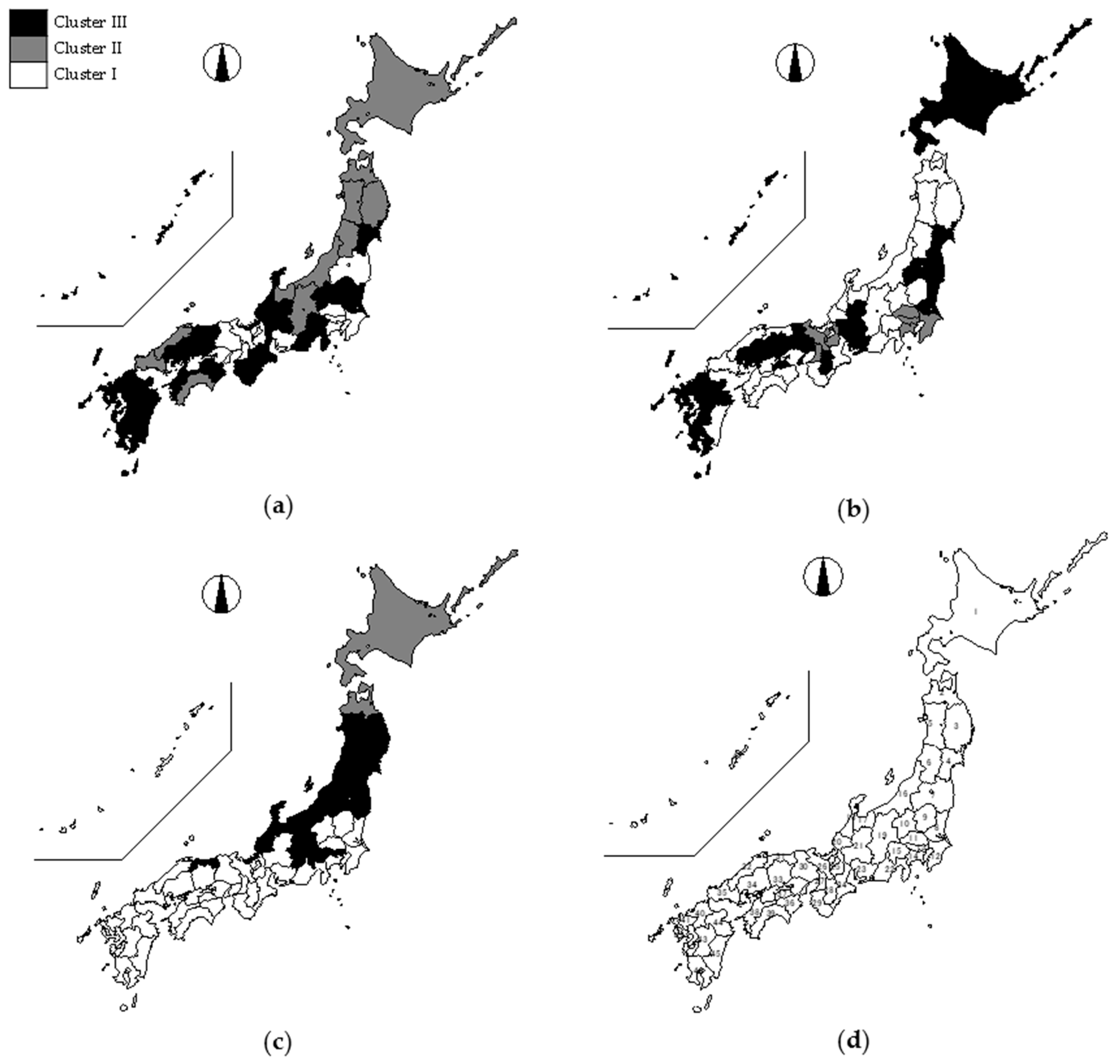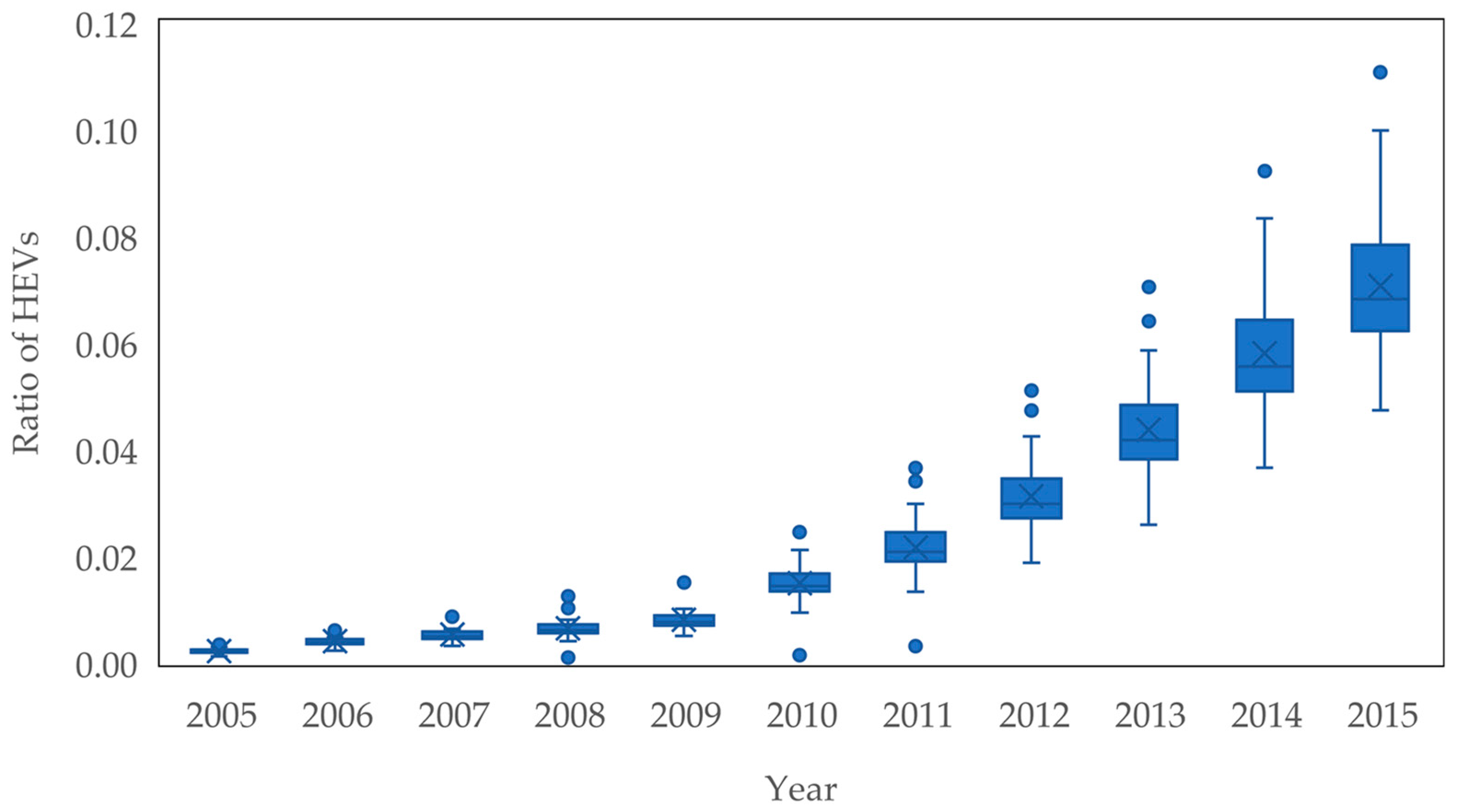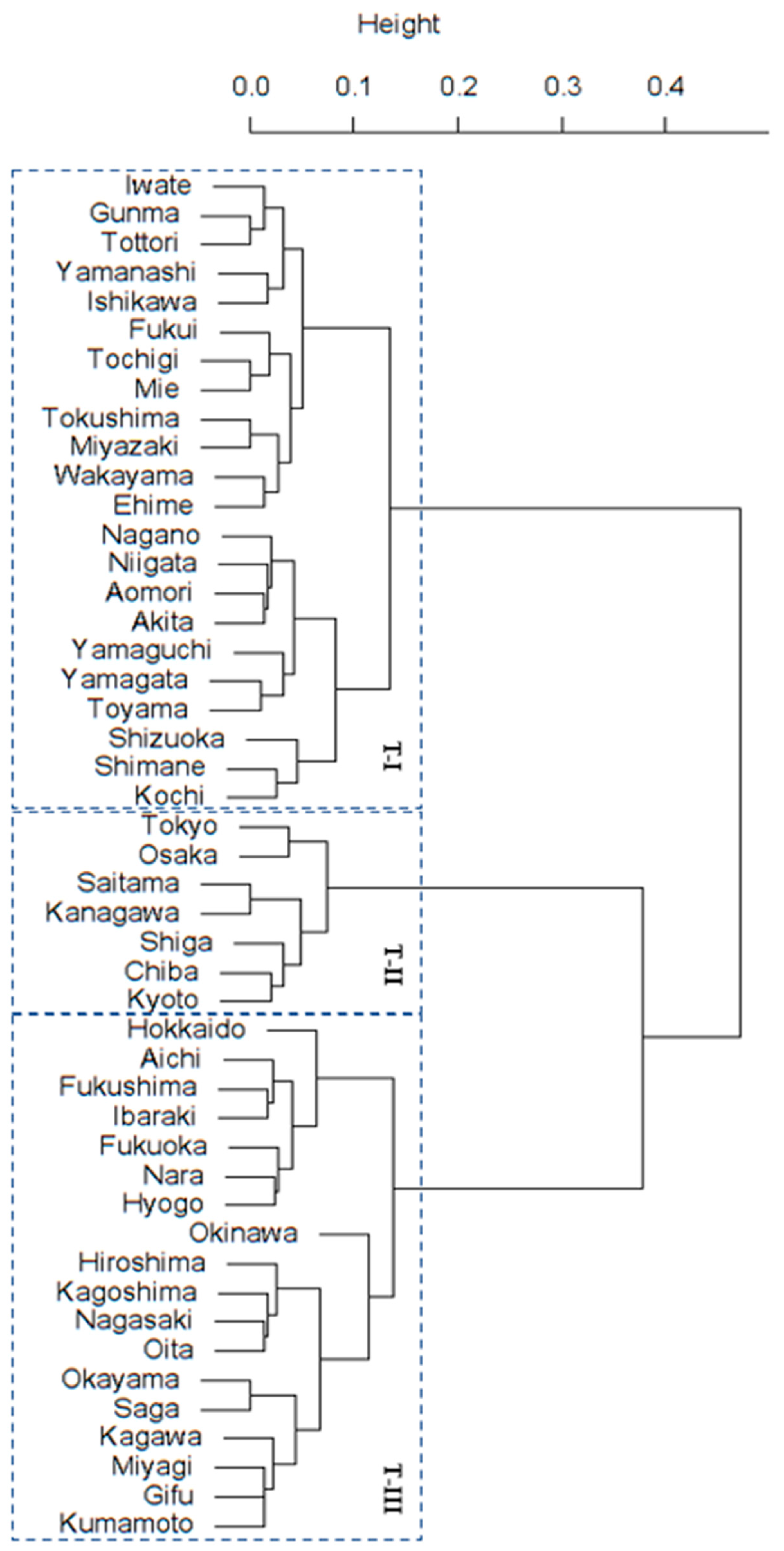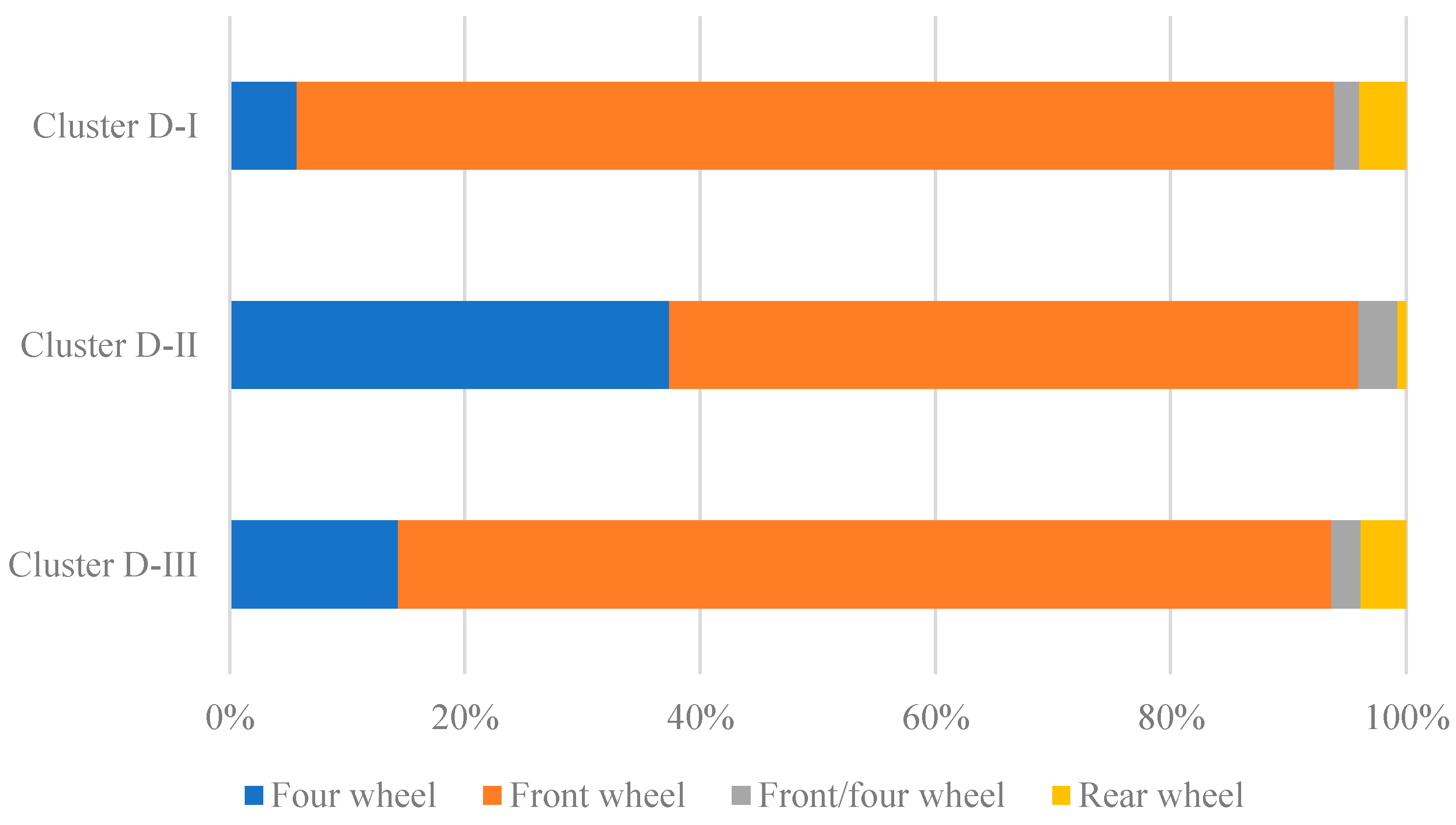Demographic, Social, Economic, and Regional Factors Affecting the Diffusion of Hybrid Electric Vehicles in Japan
Abstract
1. Introduction
2. Materials and Methods
2.1. Panel Data Regression Analysis
2.2. Cluster Analysis
3. Results and Discussion
3.1. Factors Affecting the Possession of HEVs
3.2. Regional Characteristics in the Possession of HEVs
3.2.1. Cluster Analysis of Vehicle Price Categories
3.2.2. Cluster Analysis of Body Types
3.2.3. Cluster Analysis for Drive Systems
4. Conclusions
Author Contributions
Funding
Data Availability Statement
Conflicts of Interest
Nomenclature
| Abbreviation | |
| AFV | Alternative fuel vehicle |
| BEV | Battery electric vehicle |
| CO2 | Carbon dioxide |
| EV | Electric vehicle |
| HEV | Hybrid electric vehicle |
| OLS | Ordinary least square |
| PHEV | Plug-in hybrid electric vehicle |
| SUV | Sport utility vehicle |
| Variable | |
| aging | Ratio of elderly people (over 65 years old) |
| hybrid_ratio | Ownership ratio of HEVs (passenger vehicles) |
| income | Annual income per capita |
| male | Ratio of males |
| population_per_household | Number of people per household |
| saving | Savings per household |
| subsidy | Prefecture-level subsidy for purchasing HEVs |
| university | Ratio of university entrance |
| vehicle_number | Number of passenger vehicles |
| vehicle_per_household | Number of passenger vehicles per household |
| C | Constant |
| X | Vector of independent variables |
| β | Vector of coefficients |
| α | Prefecture fixed effect |
| δ | Year fixed effect |
| ε | Error term |
| i | Prefecture |
| t | Year |
Appendix A

References
- International Energy Agency. CO2 Emissions from Fuel Combustion: Overview; International Energy Agency: Paris, France, 2020. [Google Scholar]
- Wei, W.; Cao, M.; Jiang, Q.; Ou, S.J.; Zou, H. What influences Chinese consumers’ adoption of battery electric vehicles? A preliminary study based on factor analysis. Energies 2020, 13, 1057. [Google Scholar] [CrossRef]
- Higueras-Castillo, E.; Kalinic, Z.; Marinkovic, V.; Liébana-Cabanillas, F.J. A mixed analysis of perceptions of electric and hybrid vehicles. Energy Policy 2020, 136. [Google Scholar] [CrossRef]
- Brückmann, G.; Willibald, F.; Blanco, V. Battery Electric Vehicle adoption in regions without strong policies. Transp. Res. Part D Transp. Environ. 2021, 90. [Google Scholar] [CrossRef]
- Sierzchula, W.; Bakker, S.; Maat, K.; Van Wee, B. The influence of financial incentives and other socio-economic factors on electric vehicle adoption. Energy Policy 2014, 68, 183–194. [Google Scholar] [CrossRef]
- Coffman, M.; Bernstein, P.; Wee, S. Electric vehicles revisited: A review of factors that affect adoption. Transp. Rev. 2017, 37, 79–93. [Google Scholar] [CrossRef]
- Higgins, C.D.; Mohamed, M.; Ferguson, M.R. Size matters: How vehicle body type affects consumer preferences for electric vehicles. Transp. Res. Part A Policy Pract. 2017, 100, 182–201. [Google Scholar] [CrossRef]
- Hackbarth, A.; Madlener, R. Consumer preferences for alternative fuel vehicles: A discrete choice analysis. Transp. Res. Part D Transp. Environ. 2013, 25, 5–17. [Google Scholar] [CrossRef]
- Rasouli, S.; Timmermans, H. Influence of Social Networks on Latent Choice of Electric Cars: A Mixed Logit Specification Using Experimental Design Data. Netw. Spat. Econ. 2016, 16, 99–130. [Google Scholar] [CrossRef]
- Carley, S.; Krause, R.M.; Lane, B.W.; Graham, J.D. Intent to purchase a plug-in electric vehicle: A survey of early impressions in large US cites. Transp. Res. Part D Transp. Environ. 2013, 18, 39–45. [Google Scholar] [CrossRef]
- Ferguson, M.; Mohamed, M.; Higgins, C.D.; Abotalebi, E.; Kanaroglou, P. How open are Canadian households to electric vehicles? A national latent class choice analysis with willingness-to-pay and metropolitan characterization. Transp. Res. Part D Transp. Environ. 2018, 58, 208–224. [Google Scholar] [CrossRef]
- Hahn, J.S.; Lee, J.H.; Choi, K. Heterogeneous preferences of green vehicles by vehicle size: Analysis of Seoul case. Int. J. Sustain. Transp. 2018, 12, 675–685. [Google Scholar] [CrossRef]
- D’Adamo, I.; Rosa, P. A structured literature review on obsolete electric vehicles management practices. Sustainability 2019, 11, 6876. [Google Scholar] [CrossRef]
- Mohamed, M.; Higgins, C.D.; Ferguson, M.; Réquia, W.J. The influence of vehicle body type in shaping behavioural intention to acquire electric vehicles: A multi-group structural equation approach. Transp. Res. Part A Policy Pract. 2018, 116, 54–72. [Google Scholar] [CrossRef]
- Gallagher, K.S.; Muehlegger, E. Giving green to get green? Incentives and consumer adoption of hybrid vehicle technology. J. Environ. Econ. Manag. 2011, 61, 1–15. [Google Scholar] [CrossRef]
- Abotalebi, E.; Scott, D.M.; Ferguson, M.R. Why is electric vehicle uptake low in Atlantic Canada? A comparison to leading adoption provinces. J. Transp. Geogr. 2019, 74, 289–298. [Google Scholar] [CrossRef]
- Yao, J.; Xiong, S.; Ma, X. Comparative analysis of national policies for electric vehicle uptake using econometric models. Energies 2020, 13, 3604. [Google Scholar] [CrossRef]
- Helveston, J.P.; Liu, Y.; Feit, E.M.D.; Fuchs, E.; Klampfl, E.; Michalek, J.J. Will subsidies drive electric vehicle adoption? Measuring consumer preferences in the U.S. and China. Transp. Res. Part A Policy Pract. 2015, 73, 96–112. [Google Scholar] [CrossRef]
- Kwon, Y.; Son, S.; Jang, K. Evaluation of incentive policies for electric vehicles: An experimental study on Jeju Island. Transp. Res. Part A Policy Pract. 2018, 116, 404–412. [Google Scholar] [CrossRef]
- Diamond, D. The impact of government incentives for hybrid-electric vehicles: Evidence from US states. Energy Policy 2009, 37, 972–983. [Google Scholar] [CrossRef]
- Morton, C.; Anable, J.; Yeboah, G.; Cottrill, C. The spatial pattern of demand in the early market for electric vehicles: Evidence from the United Kingdom. J. Transp. Geogr. 2018, 72, 119–130. [Google Scholar] [CrossRef]
- Kester, J.; Sovacool, B.K.; Noel, L.; Zarazua de Rubens, G. Rethinking the spatiality of Nordic electric vehicles and their popularity in urban environments: Moving beyond the city? J. Transp. Geogr. 2020, 82. [Google Scholar] [CrossRef]
- Automobile Inspection & Registration Information Association. Trends in Vehicle Possession in Japan. Available online: https://www.airia.or.jp/publish/statistics/trend.html (accessed on 3 December 2019).
- Cabinet Office. Annual Report on Prefectural Accounts. Available online: https://www.esri.cao.go.jp/jp/sna/sonota/kenmin/kenmin_top.html (accessed on 4 February 2020).
- Statistical Bureau of Japan. Survey of household economy. Available online: https://www.stat.go.jp/english/data/joukyou/index.html (accessed on 4 February 2020).
- Statistical Bureau of Japan. Population Census. Available online: https://www.stat.go.jp/english/data/kokusei/index.html (accessed on 4 February 2020).
- Ministry of Education, Culture, Sports, Science and Technology. Report on Basic Research on School. Available online: https://www.mext.go.jp/b_menu/toukei/chousa01/kihon/1267995.htm (accessed on 4 February 2020).
- Shiraki, H.; Matsumoto, K.; Shigetomi, Y.; Ehara, T.; Ochi, Y.; Ogawa, Y. Factors affecting CO2 emissions from private automobiles in Japan: The impact of vehicle occupancy. Appl. Energy 2020, 259. [Google Scholar] [CrossRef]
- Acar, A.; Takahashi, H. A discussion of gender response on advertising research. Kwansei Gakuin Shogaku Kenkyu 2009, 60, 75–89. [Google Scholar]
- Edenhofer, O.; Pichs-Madruga, R.; Sokona, Y.; Seyboth, K.; Matschoss, P.; Kadner, S.; Zwickel, T.; Eickemeier, P.; Hansen, G.; Schlomer, S. (Eds.) Renewable Energy Sources and Climate Change Mitigation; Cambridge University Press: Cambridge, UK, 2011. [Google Scholar]







| Independent Variables | Definition | Sources |
|---|---|---|
| subsidy | Prefecture-level subsidy for purchasing HEVs. A dummy variable that takes a value of one if a subsidy exists and zero otherwise. | Website of and inquiry from each prefecture |
| income (thousand JPY) | Annual income per capita | [24] |
| saving (thousand JPY) | Savings per household | [25] |
| population_per_household | Number of people per household | Calculated based on the data from [26] |
| vehicle_number | Number of passenger vehicles | [23] |
| vehicle_per_household | Number of passenger vehicles per household | Calculated based on the data from [23] and [26] |
| university | Ratio of university entrance (i.e., indicator of higher education) | [27] |
| aging | Ratio of elderly people (over 65 years old) | [26] |
| male | Ratio of males | [26] |
| Variables | Mean | S.D. | Min. | Max. |
|---|---|---|---|---|
| hybrid_ratio | 0.024 | 0.024 | 0.00094 | 0.11 |
| subsidy | 0.077 | 0.088 | 0 | 1 |
| income | 4359.75 | 449.01 | 3365.24 | 6360.33 |
| saving | 11910.89 | 3020.89 | 3510 | 20390 |
| populaion_per_household | 2.50 | 0.23 | 1.97 | 3.13 |
| vehicle_number | 1239511.54 | 892405.18 | 310522 | 4064359 |
| vehicle_per_household | 1.42 | 0.82 | 0.26 | 5.24 |
| university | 0.50 | 0.072 | 0.31 | 0.67 |
| aging | 0.25 | 0.034 | 0.16 | 0.34 |
| male | 0.48 | 0.010 | 0.47 | 0.51 |
| (1) Pooled OLS | (2) One-Way Fixed Effects | (3) Two-Way Fixed Effects | |
|---|---|---|---|
| subsidy | 0.00298 | 0.000601 | −0.00196 |
| (0.00737) | (0.00405) | (0.00190) | |
| income | 4.32 × 10−7 | 1.40e × 10−5 *** | −1.08 × 10−6 |
| (2.34e × 10−6) | (2.85 × 10−6) | (1.50 × 10−6) | |
| saving | 1.88 × 10−8 | 5.72 × 10−7 *** | 2.27 × 10−8 |
| (2.97 × 10−7) | (1.89 × 10−7) | (9.03 × 10−8) | |
| population_per_household | −0.0342 *** | 0.0148 | 0.0603 *** |
| (0.00403) | (0.0144) | (0.00952) | |
| vehicle_number | 2.38 × 10−9 ** | 5.51 × 10−8 *** | 3.06 × 10−8 *** |
| (1.16 × 10−9) | (1.50 × 10−8) | (7.14 × 10−9) | |
| vehicle_per_household | −0.00130 | −0.0143 | −0.174 *** |
| (0.000876) | (0.0250) | (0.0133) | |
| university | 0.0315 ** | −0.170 *** | 0.0221 |
| (0.0140) | (0.0214) | (0.0160) | |
| aging | 0.562 *** | 1.158 *** | −0.176 *** |
| (0.0265) | (0.0695) | (0.0525) | |
| male | 1.280 *** | 0.328 | 0.636 ** |
| (0.102) | (0.549) | (0.262) | |
| Constant | −0.666 *** | −0.489 * | −0.220 * |
| (0.0466) | (0.273) | (0.131) | |
| R-squared | 0.629 | 0.909 | 0.981 |
| Prefecture fixed effect | No | Yes | Yes |
| Year fixed effect | No | No | Yes |
| Coefficients (Standard Errors) | Coefficients (Standard Errors) | ||
|---|---|---|---|
| year2006 | 0.00509 (0.000935) | year2011 | 0.0315 (0.00276) |
| year2007 | 0.00831 (0.00132) | year2012 | 0.0448 (0.00313) |
| year2008 | 0.0103 (0.00171) | year2013 | 0.0598 (0.00365) |
| year2009 | 0.0135 (0.00212) | year2014 | 0.0780 (0.00413) |
| year2010 | 0.0222 (0.00246) | year2015 | 0.0938 (0.00461) |
Publisher’s Note: MDPI stays neutral with regard to jurisdictional claims in published maps and institutional affiliations. |
© 2021 by the authors. Licensee MDPI, Basel, Switzerland. This article is an open access article distributed under the terms and conditions of the Creative Commons Attribution (CC BY) license (https://creativecommons.org/licenses/by/4.0/).
Share and Cite
Matsumoto, K.; Nakamine, Y.; Eom, S.; Kato, H. Demographic, Social, Economic, and Regional Factors Affecting the Diffusion of Hybrid Electric Vehicles in Japan. Energies 2021, 14, 2130. https://doi.org/10.3390/en14082130
Matsumoto K, Nakamine Y, Eom S, Kato H. Demographic, Social, Economic, and Regional Factors Affecting the Diffusion of Hybrid Electric Vehicles in Japan. Energies. 2021; 14(8):2130. https://doi.org/10.3390/en14082130
Chicago/Turabian StyleMatsumoto, Ken’ichi, Yui Nakamine, Sunyong Eom, and Hideki Kato. 2021. "Demographic, Social, Economic, and Regional Factors Affecting the Diffusion of Hybrid Electric Vehicles in Japan" Energies 14, no. 8: 2130. https://doi.org/10.3390/en14082130
APA StyleMatsumoto, K., Nakamine, Y., Eom, S., & Kato, H. (2021). Demographic, Social, Economic, and Regional Factors Affecting the Diffusion of Hybrid Electric Vehicles in Japan. Energies, 14(8), 2130. https://doi.org/10.3390/en14082130






